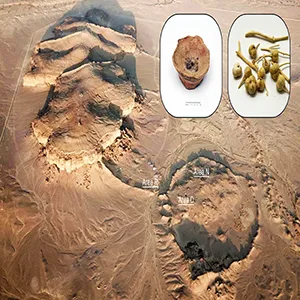
People were getting high and hallucinating from smoking this psychoactive plant 2,700 years ago
New analysis of ancient household burners from Qurayyah in northwest Saudi Arabia points to smoke from Peganum harmala seeds being inhaled in daily life nearly 2,700 years ago.
The work opens a window onto how Iron Age communities used scent, smoke, and bioactive plants to manage health and mood without leaving written manuals.
The evidence comes from residues preserved inside clay fumigation devices recovered in domestic courtyards and storage areas. Researchers report plant signatures that hold up even after centuries of heat and decay.
Dr. Barbara Huber, Max Planck Institute of Geoanthropology (MPI GEA), and Prof. Marta Luciani, University of Vienna, led the study with the Heritage Commission of the Saudi Ministry of Culture.
Peganum harmala residue
The team detected two beta-carboline alkaloids, harmine and harmane, inside three Iron Age burners from Qurayyah. These molecules are hallmarks of Peganum harmala, a hardy desert shrub often called Syrian rue.
One additional burner from the same settlement lacked those alkaloids but held a different class of plant compounds, α-amyrin and β-amyrin. That pattern hints at alternating or mixed substances burned in the same kinds of devices.
“Our findings represent chemical evidence for the earliest known burning of harmal, not just in Arabia, but globally,” said Barbara Huber, lead author of the study.
The devices were not found in graves or temples, but in houses. That domestic context suggests ordinary uses tied to health, sanitation, or mood rather than large public rites.
Identifying the evidence
The study used targeted HPLC-MS/MS to read a molecular fingerprint from residue trapped in the clay matrix. In short runs, the instrument looked for specific ion transitions that match harmine and harmane with high confidence, even at low abundance.
“The integration of biomolecular analysis with archaeology has allowed us to identify not just what kind of plants people were using, but also where, how, and why,” said Prof. Luciani.
In archaeology, this kind of precise mass spectrometry helps answer not only what plant was there, but also how it was used.
Three burners carried harmine and harmane, while a fourth did not. That contrast matters because it rules out random contamination and points to intentional selection of materials for specific effects.
The context also matters. One burner with harmala signatures sat in a household courtyard, and another was linked to food production areas. Those findspots align with routine, indoor smoke use.
What Peganum harmala does
Harmine and harmane are reversible inhibitors of monoamine oxidase A, an enzyme that breaks down neurotransmitters such as serotonin and norepinephrine.
Temporarily slowing that enzyme can lift neurotransmitter levels, which helps explain mood and sensory shifts.
These alkaloids occur in several plants, but regional distribution narrows the list of plausible sources for Iron Age Arabia.
Reviews catalog harmala alkaloids across taxa, including South American vines and some Passiflora species, yet those grow far from ancient Qurayyah.
Dose and route shape the experience. Small exposures can relax or mildly stimulate, while larger exposures can bring on vivid effects.
High amounts may cause sickness, which modern case reports document in clinical settings after ingestion of concentrated seeds.
Smoke is a different route than tea or tincture. Inhalation can deliver a quick, shorter-lived exposure in rooms where airflow, fuel, and seed load all change the outcome.
Signals from other residues
The amyrin-rich burner adds another layer. Pharmacology reviews note anti-inflammatory and analgesic actions for these isomers in preclinical models.
Finding amyrins without harmala alkaloids in one device, and together in another, suggests people alternated recipes or blended resins with seeds depending on purpose. That kind of flexibility lines up with practical home use.
These chemical signatures do not name a resin to species. They do, however, flag a class of botanicals that humans have burned for centuries for their scent and perceived health effects.

A wider cultural thread
Ethnobotany and pharmacognosy track how communities use plants both as medicine and as part of everyday life. Reviews of Peganum harmala describe continued roles in West Asia and North Africa, including pain relief, calming, and household fumigation traditions.
The antimicrobial angle has support, too. A laboratory study of smoke condensates from P. harmala seeds reported clear antibacterial activity and identified harmine as a major constituent in the smoke matrix.
Households in an oasis settlement needed tools to manage pests, odors, and illness in tight quarters. A pungent seed with antimicrobial constituents and mood effects would be a practical choice.
Peganum harmala adds to Arabian history
Written sources for medicinal plants in Arabia become richer much later. For the Iron Age, physical residues tell the story.
They show people selecting a local shrub with psychoactive and antibacterial properties, then burning it in domestic spaces.
The Qurayyah finds help to push beyond broad claims about ancient drugs. They connect a plant to a device, a device to a room, and a room to routines that touch health and emotion.
This work also shows how careful chemistry can recover silent practices. Even when seeds are gone and recipes are lost, compounds cling to clay and speak for themselves.
Where the research goes next
Future work can test more burners from other rooms and towns to see if this pattern holds. It can also examine how resin mixtures changed the experience, from scent to smoke quality to perceived relief.
The method can scale. Each new residue map helps reconstruct a more precise history of household care, sanitation, and sensory life across ancient Arabia.
Modern science can also reevaluate forgotten botanicals. Some may carry leads for safe, targeted therapies, while others serve as cautionary tales about dose and context.
The study is published in Communications Biology.
—–
Like what you read? Subscribe to our newsletter for engaging articles, exclusive content, and the latest updates.
Check us out on EarthSnap, a free app brought to you by Eric Ralls and Earth.com.
—–













